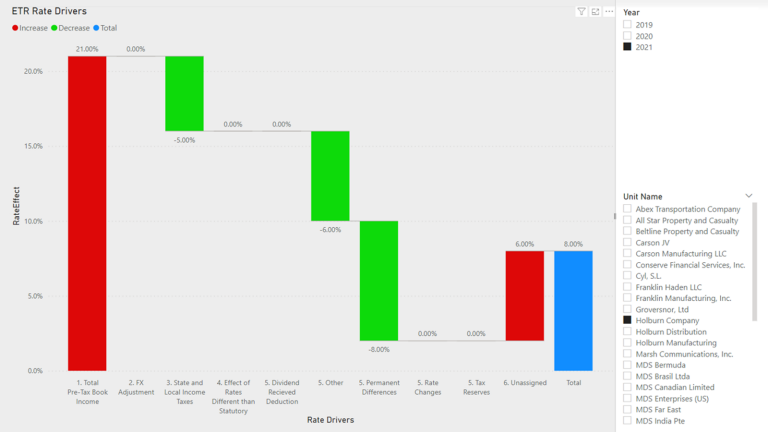Current income tax expense, deferred income tax expense, how to use AI to calculate tax provision, and more.
Understanding the concept of tax provisions is essential for a business to accurately reflect its tax obligations in its financial statements. In this blog, we will dive into what tax provisions are and provide a clear guide on how to calculate the provision for income tax, ensuring clarity and precision for corporate finance departments.
Jump to ↓
How to calculate provision for income tax
Income tax provision calculation challenges
4 steps to improve your tax provision calculation process and results
How tax provision software can help
What is a tax provision?
A tax provision is the estimated amount of income tax that a company is legally expected to pay to the IRS for the current year. It is just one type of provision that corporate finance departments set aside to cover a probable future expense. Other types of provisions a business typically accounts for include bad debts, depreciation, product warranties, pensions, and sales allowances.
Tax provisions are considered current tax liabilities for the purpose of accounting because they are amounts earmarked for taxes to be paid in the current year. Complexities arise when knowing how to prepare for tax provision calculation in a way that is best for the business while being fast, accurate, and defendable. Estimating each year’s tax provision is not a menial task and can require a great deal of time and effort for corporate tax departments.
How to calculate provision for income tax
A company’s tax provision has two parts: current income tax expense and deferred income tax expense. Most accounting departments use Generally Accepted Accounting Principles (GAAP) to calculate their financial position. GAAP procedures differ in important ways from income tax accounting rules. These differences play a major role in the calculation of current and deferred income tax expenses.
Current income tax expense
The current tax expense is the amount of income tax a company will pay for the current year. It is calculated from current earnings and the current year’s permanent differences and temporary differences between the GAAP and income tax rules. The following steps outline how you calculate current income tax provision:
- Start with your company’s net income. This is your income as calculated by GAAP rules before income taxes.
- Calculate the current year’s permanent differences. These are income items or expenses that are not allowed for income tax purposes but that are allowed for GAAP. Because these expenses or income items are disallowed or not recognized for income tax purposes, they are considered permanent. Examples of permanent differences include fines and penalties, entertainment expenses, municipal bond interest, and life insurance proceeds.
- Calculate the current year’s temporary differences. These are expenses or income items that are allowed for either GAAP or income tax purposes in one year, but not under the other accounting system until a later year. Determine your company’s temporary differences by reviewing the current year balance sheet and identifying differences between your GAAP calculations and your income tax calculations. Common temporary differences include expenses incurred but not yet paid, and depreciation.
- Apply credits and net operating losses (NOL). After you have accounted for these differences, you land on your current year taxable income. You can now apply credits and NOL.
- Apply the current tax rate. Multiply the current year taxable income by your current statutory federal tax rate. The result is your company’s current year tax expense for the income tax provision.
Deferred income tax expense
The deferred income tax is a liability that the company has on its balance sheet but that is not due for payment yet. This more complicated part of the income tax provision calculates a cumulative total of the temporary differences and applies the appropriate tax rate to that total. It focuses on the deferred effects of income, expenses, NOL, and tax credits. After this calculation, you’ll account for your deferred tax expense on your company’s GAAP balance sheet as an asset or liability depending on whether you will owe tax or will receive a tax benefit in the future.
Income tax provision calculation challenges
Calculating tax provision is complex and challenging. Corporate tax teams face the following common tax provision calculation issues.
- Out-of-sync income reporting. Getting your calculation right requires starting with the right number for your net income. Most companies report income annually or quarterly, so the tax provision amount can only be estimated.
- Difficulty gathering and integrating the right data. Bringing together data for your calculation from the finance and tax departments, as well as integrating and properly structuring it, is complicated.
- Handling a large volume of data. Even the simplest calculation can require a team of tax experts to examine items such as annual reports, financial statements, tax payments, and net income.
- Keeping up with tax law changes. Tax law changes affect your calculation formulas. Your tax department must stay on top of these new regulatory requirements.
- Reliance on manual calculation processes. Calculating the corporate tax provision using spreadsheets and manual processes can slow down your ability to get accurate, compliant data in a timely manner.
4 steps to improve your tax provision calculation process and results
With the right approach, your tax department can get better, faster tax provisioning results, reduce your tax provision obligations, and reduce errors and risks in tax provisioning. Here are the steps to consider:
- Harness and analyze your data using AI. AI tools can automatically collect financial data from various sources, such as accounting systems, ERP systems, and other financial databases. AI can also standardize and clean the data, ensuring consistency and reducing errors. Just make sure your use of AI is ethical and secure.
- Consult tax provision checklists. Use tools such as the industry-leading Thomson Reuters Corporate Income Tax Provision Checklists to assess income tax measurement processes, disclosure requirements, and risk management controls.
- Review your compliance. Look closely at your tax provision calculation process to verify that you are using the right criteria to calculate tax provision.
- Opt for automation. Those processes that are laborious or error-prone can be improved with a tax provisioning solution that delivers faster, more accurate data collection, consolidation, and analysis.
How tax provision software can help
Corporate tax provision software incorporates automation and other technologies that can speed your tax provisioning calculation in several ways. The right tax provision software helps eliminate errors and streamline your tax calculation processes so you can complete filing obligations easily. Tax provision software delivers the tools to help you respond to regulatory changes around the world in nearly any jurisdiction. Tax departments are reporting up to 50% faster processing with some tax provision software, along with other improved results.
Tax provision software such as Thomson Reuters ONESOURCE Tax Provision gives your organization the ability to balance compliance needs with accurate tax provisioning while ensuring a defendable process.
Some benefits of ONESOURCE Tax Provision:
- Simplify data capture and manage multiple sources of data within one tool
- Direct connectivity with the general ledger for automation of tax attributes
- Web-based data collection for real-time updates from remote users
- Push and pull data from Excel workpapers
- Extract data to automate offline calculations for use in other applications
- Configurable data entry screens for manual and top-side entries
Contact us to learn more about ONESOURCE Tax Provision today.

Tax provision software
Automate your corporate financial close with ONESOURCE Tax Provision
Learn more ↗







